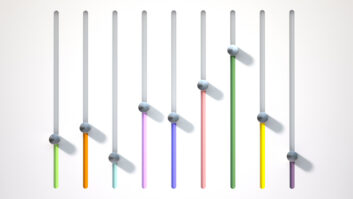Production from the Field
May 1, 2010 12:00 PM, By Ron Bartlebaugh, CBNT
Trends in Technology, May 2010

The market’s response to an increased flurry of audio gathering and production in the field has brought us new products and gadgetry. Creative spirits have been ignited to greater levels with tools that are now, more than ever, highly versatile, powerful and compact. A simple news reporter field kit used to consist of a heavy tape recorder and a bulky microphone. Now a solid-state recorder with many hours of recording time, a built-in microphone, and an internal microprocessor so feature packed that it rivals audio software found on many desktop computers, fits in the palm of your hand. Audio recording and distribution applications for smart phones are developing at an unforeseen pace. When marrying existing technologies with new, the end results can be remarkable. While we look at cutting-edge technology, we need to be mindful of many long-time basics � especially when responsible for one-shot, one-take productions.
Phone it in

The iPhone has made an obvious mark on technology users, and several companies are capitalizing on the device’s popularity. Tieline recently announced its Report-IT Live iPhone application for wireless IP reporting. The application turns an iPhone into an IP audio codec for live, portable, two-way wireless news gathering. The application enables the phone connection to an in-studio Tieline codec. The iPhone can, among many other features, be used to simultaneously report and record live or record and forward at a later time.

Comrex recently introduced a free app called the Access Reporter Codec (ARC). ARC makes an IP call over an Android-based mobile phone’s 3G or Wi-Fi channel to a selected Access or Bric-Link codec in the studio using a high-quality wideband, full-duplex audio channel between the two devices.

For Enco program automation software users, the company recently announced its iDAD product for use with the iPhone and iPad. The iDAD provides for the record, trim and tail, and labeling of audio for transmission to in-station Enco DAD and Presenter systems. Remote control of those systems is also possible through the iPhone and iPad.

Similarly, RCS has released the iPush, which allows users to voice track and upload files to RCS NexGen Digital systems via an iPhone.
— continued on page 2
Production from the Field
May 1, 2010 12:00 PM, By Ron Bartlebaugh, CBNT
Trends in Technology, May 2010

JK Audio offers several products for use with Bluetooth-equipped phones. The BlueDriver uses Bluetooth wireless technology to send and receive audio from professional audio equipment. The BlueDriver model F3 connects directly to the mic-level audio output of an audio mixing console or to a dynamic microphone. The model M3 connects to the microphone input channel of an audio mixer. If you need maximum portability, the JK Audio BlueKeeper wireless audio gateway provides a method for conducting and recording desktop interviews using a cell phone.
There are many options available to send audio to the studio from the field. DSL, cable modem, IP, Wi-Fi, 3G and 4G networks, BGAN/VSAT, PSTN and ISDN (albeit to a lesser degree now) are all viable options. It used to be that codecs were designed to work with one or two services; now, for the most part, many codecs can interface with almost any available interface. Some may require optional interface modules. And thanks to cooperative standard setting efforts, different brands of codecs can easily be used on each end of a path. Equipment from Tieline, AEQ, Telos, Comrex, Barix, AETA, APT, Musicam, MDO, Mayah and others can typically find common ground to establish an audio pathway.
Recording and editing
The availability of audio recording and editing software for computers is at an all-time high. USB interfaces provide for easy routing of audio to and from a computer. Laptops have made portable recording and production increasingly convenient. Portability is often further enhanced with the addition of a wireless network card for point-to-point transmission or posting of audio from any Internet access location.

Two recorders that look like a microphone are the Yellowtec iXM and HHB FlashMic. These both combine a studio-quality microphone element with a flash recorder. The iXM stores audio on SD cards and is powered by a dual power source: An internal, rechargeable LiON supply powers the recorder up to 8 hours, while three AAA batteries can be installed to double that time. A line-in jack is standard. Mic capsules manufactured by Yellow and Beyer Dynamic are available in omni, cardioid and super-cardioid (six total capsule choices). A headphone jack and USB port round out the connections. The recorder controls are placed comfortably on the side of the mic body.
The Flashmic can transfer files via USB, and is available with an omni-directional or cardioid mic element. Its 1GB flash recorder provides up to 18 hours of recording time depending on recording mode. The DRM85-1 features a line input that is convenient for connection to a press box. All models sport a headphone jack with volume control. Continuous operating time for the two on-board AA batteries is quoted at 8 hours.
— continued on page 3
Production from the Field
May 1, 2010 12:00 PM, By Ron Bartlebaugh, CBNT
Trends in Technology, May 2010
There are a plethora of small portable recorders available. There are many and most are highly worthy of consideration. A good overview of these products can be found in the February 2010 Trends in Technology feature of Radio magazine. Be sure to purchase a unit that provides phantom power if your microphone requires such.
These products, plus new equipment announced at the NAB Show create new opportunities for versatile production at affordable costs. Balanced with terms such as compact and feature-filled are long-established practices that require proper diligence to assure a successful field production.
Established practices
Battery management is mandatory. Field production equipment still requires power. Many units now have internal batteries that recharge via a USB connection. Others operate on multiple AA or AAA batteries � some of which can be recharged in the field. Lithium batteries, the type typically used in digital cameras, are a better choice for longer life expectancy. Always become keenly aware of your unit’s power requirements, run times, recharge methods, and battery replacement procedures and requirements. Write the date and time on each battery during initial installation and each subsequent replacement so as to not confuse bad with good. Develop an established plan for battery replacement or recharge as necessary during long-run productions. Keep a log of battery activity and usage when multiple field units are in use. Cell phones used for remote broadcasts from sports or business venues may require an external battery source if commercial power is not available at the location.
Machine recording time has become an increasingly confusing matter. It used to be that a 7.5″ tape reel would yield x recording time dependent upon its speed of operation. Present-day recording format times vary widely by the amount of on-board and/or portable memory storage, recording mode, audio format, sample rate and bit rate. Times can range from a few minutes to many hours. As a general rule of thumb, the higher the desired quality of the recording, the lower the recording time for a given amount of storage. The issue of available recording time directly correlates to the run time of the machine’s power source. Plan both accordingly so you don’t run out of one or the other in the middle of an important press conference or symphony performance. For machines that use portable storage media, always carry extras in case of loss, defective operation, or need for additional storage space.
Use of the proper microphone type for any event is essential. Omni-directional microphones pick up sound in a 360-degree pattern whereas cardioid mics typically have a 180-degree sound pick up effectiveness. Long, narrow shotgun microphones have a very narrow sound pick up angle and are an excellent choice for sound pickup at farther distances � especially if one needs to gather sound bites for an important feature story. Head worn microphones � the type that are a headphone with an attached boom microphone � are a favorable choice for sportscasters and newscasters who anticipate being on-site for long periods of time. Clip-on lapel microphones are often beneficial when recording multiple guests during an interview segment. Ribbon element microphones have seen renewed popularity and are frequently a good choice for specialized applications including the recording of bands, orchestras and choral groups. A microphone that contains a condenser element requires phantom power for proper operation. That power is sometimes available from an internal battery; however, most units seek power from the connected audio mixing console or recorder. Once again, the iPhone comes into play, and add-on mics for the device, such as the Blue Microphones Mikey, are practical options for improved audio capture. Always gain knowledgeable advice when placing your microphone selections to assure best long-term results.
Be prepared
When entering the production field, do so with enough microphones, cables, adapters, headphones, batteries, memory storage media and whatever else you might need to get the job done. Press conferences often require special and sometimes unusual methods of microphone attachment to podiums. Microphone windscreens can be invaluable when recording at outdoor venues. A person cannot carry too many adapters of various types related to the mission at hand. And, always have your stuff close by in the event of quick need. Don’t park the car 10 blocks away only to realize there is no time to return for that one thing you need but don’t have with you.
Permanently label and otherwise identify your equipment. When at major events where multiple media personnel are in attendance there will be lots of equipment in use � some perhaps the same make and model as yours. Confusion over what equipment belongs to who can easily cause inerrant departure of your equipment. Maintain a record of all equipment including brand, model number, serial number and method of ownership identification. When at an event, watch over your equipment carefully. Guard that rare, just-recorded, once-in-a-lifetime opportunity, award-winning interview.
With so much advanced technology now available, opportunities are greater than ever for the capture, editing, and transmission of audio in a swift and efficient manner from practically anywhere. So head to your favorite coffee shop’s Wi-Fi spot and have fun!
Bartlebaugh is director of broadcast engineering, the WKSU Stations, Kent State University, Kent, OH.







